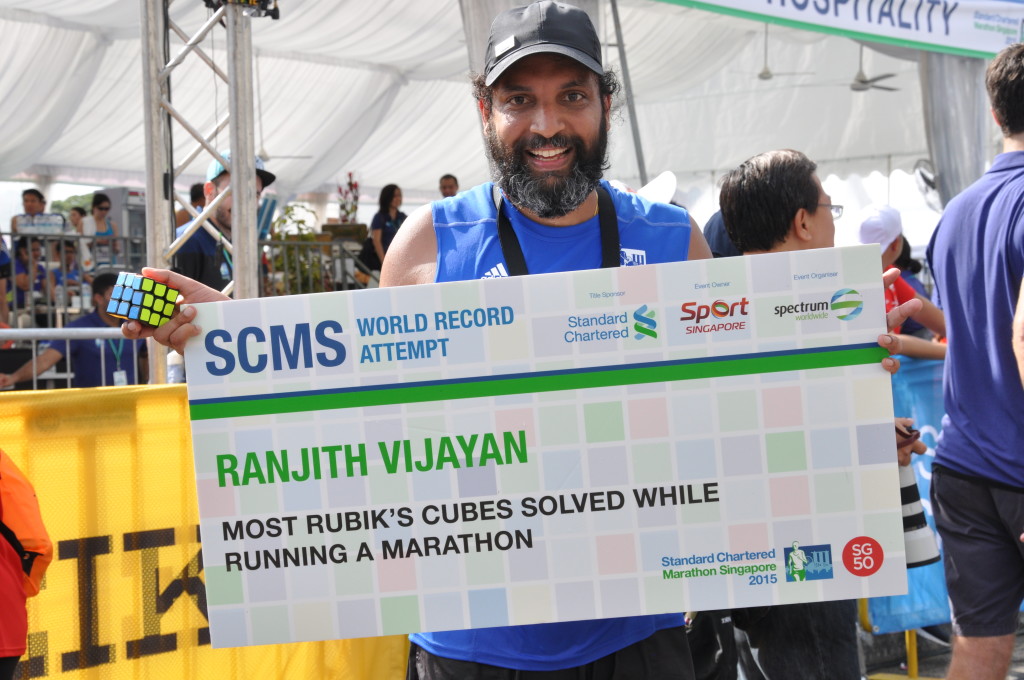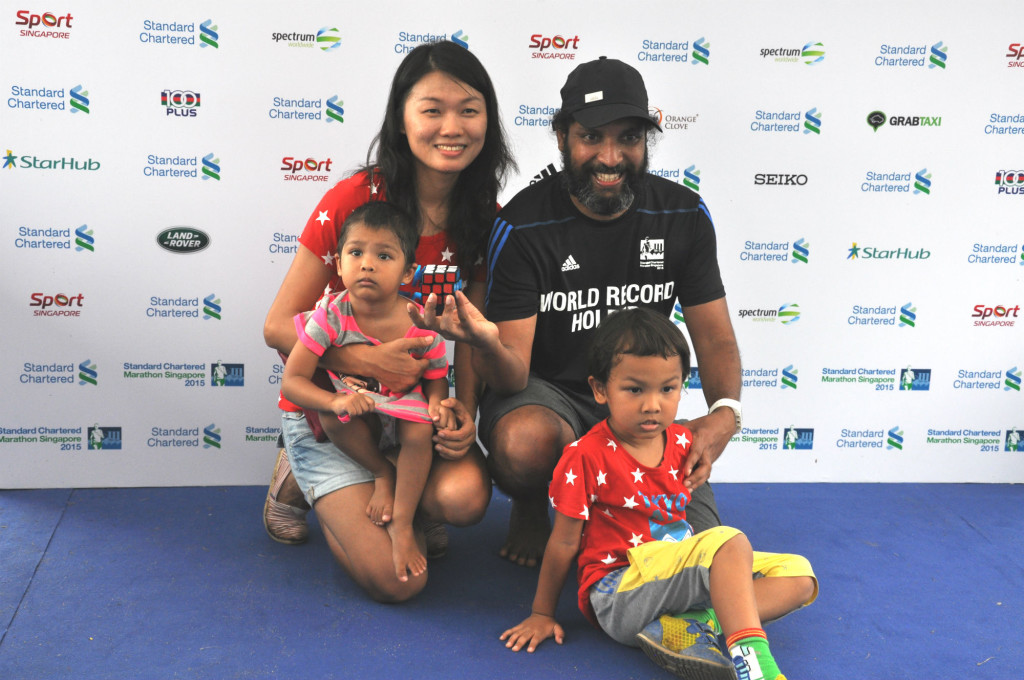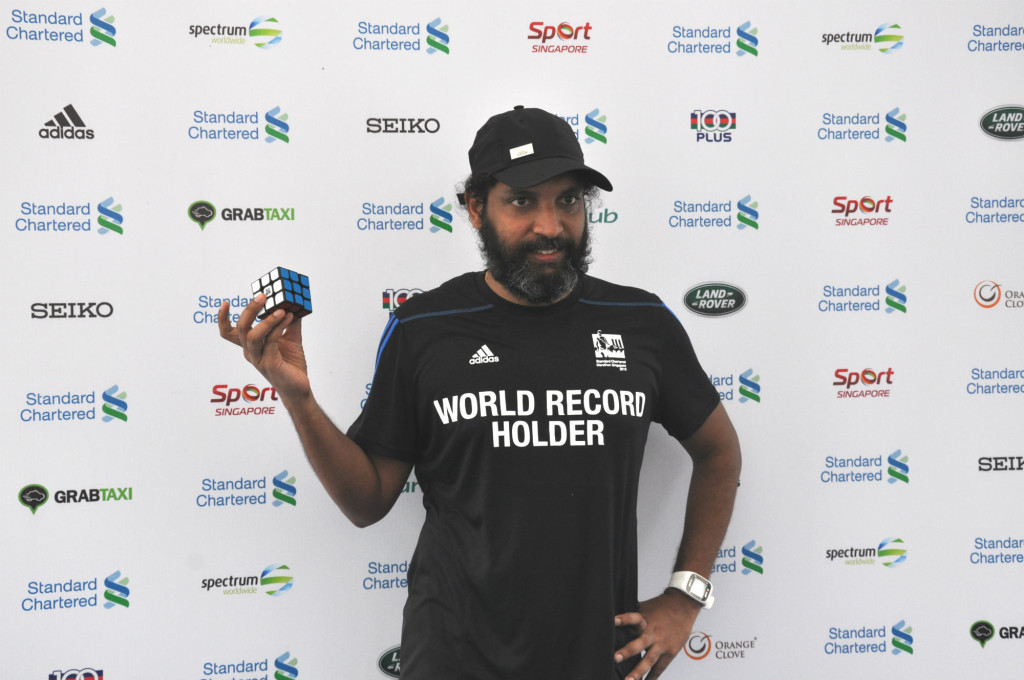Yesterday at the 2015 edition of the StanChart Marathon Singapore (SCMS), he succeeded in setting a Guinness World Record, pending verification from Guinness.
No, the record was not for the fastest marathon timing… but instead, for the most number of Rubik’s Cubes completed while running a marathon.
Successfully solved 200 Rubik’s Cubes at SCMS
Computer programmer Ranjith Vijayan, 37, successfully solved 200 Rubik’s Cubes at this year’s SCMS, within the five-hour marathon time limit set by the record adjudicator. The previous record had stood at 175 cubes.
With him were two pacers, both from the marathon’s official pace group Running Department, to help him carry the Rubik’s cubes in a backpack and at the same time, ensure that he was able to maintain his sanity throughout the marathon.
Said Vijayan, “After I crossed the finishing line, I was relieved – for my pacers, actually. They were a great help and if I had not made it, I would have felt really bad for not succeeding. They not only helped me by “pulling” me along and giving me plenty of moral support during the last 5km – but they had to carry 15 cubes in a backpack at a time, which weighed about 1.5kg.”
Without them, Vijayan adds that he would not have been able to succeed in breaking the record, as he had been tempted to stop and take a break during the final stages of his marathon run.
Most challenging part was the heat during the final 5km
He continued, “Solving the cubes had been the easy part. But the most challenging thing was the final 5km of the run, due to the heat.”
Added Vijayan, in jest, “My pacers practically took my hands and ‘dragged’ me to the finishing line!”
Because of the five-hour time limit, Vijayan had half an hour left to complete the last 5km of the run. If he failed to finish the run within five hours, his record would not stand. So the mental pressure became very intense, especially with the heat beating ferociously down on him.
He added, “The water stations had been pretty far apart during that final 5km stretch and that didn’t help either. Because I was running barefoot too, the road was getting hotter and this made every step hard to take. These factors all came together and gave me a real challenge.”
Lots of logistical challenges
There were also plenty of logistical challenges with regards to storing the cubes during the marathon, Vijayan pointed out. He said, “We had bags of 15 cubes kept at different water stations along the route. I finished solving all my cubes at the 31km mark of the marathon, that is, at the 13th water station. We had initially targeted 300 cubes, but due to the logistics involved, we had to lower our target to 200. Bringing so many cubes into a run is difficult, especially considering that you’re not allowed to use the same cube.”
Continued Vijayan, “At each of the water stations, the volunteers were informed when I was approaching so they gave all the cubes to us and we gave them the completed cubes. Each set of cubes were about two to three kilometres apart, but I was able to solve all 15 cubes within about one kilometre, 1.2km at the most.”
Cubing initially began as a way to relieve the boredom of running
Vijayan initially came up with the idea of pairing up Rubik’s cubing together with running – as a way of conquering the boredom while pounding the pavements. Initially when he had started running, he had thought it was quite boring, and began looking for ways to spice up running.
So being passionate about cubing, he tried it out and found that it worked for him – much like how many people listen to music as they run.
Tips and methods for solving Rubik’s Cubes
What tips does Vijayan have, for solving Rubik’s Cubes?
He said, “There are various methods. You can solve without using a method, that is just intuitively and by trial and error, but for me, I was following a popular method known as Fridrich’s Method for the 3×3 speed cubing during the marathon.”
One of the most common methods used in Rubik’s cubing, Fridrich’s Method works on a layer by layer method, firstly focusing on solving a cross on the bottom of the cube, then looking at cracking the first two layers, orienting the last layer and then finally permuting the last layer algorithms as the last step.
Added Vijayan, “I have a collection of various other cubes such like the 4×4, 5×5 and pyramid cubes, which I solve intuitively without any structured methods though. But for the 3×3 cubes, I find the Fridrich’s Method easy because I just need to memorise how to turn the cube and recognise the colours and my fingers will move automatically – so I don’t need to think. That helped a lot during the marathon when I was getting tired.”
Click here for my SCMS 2015 race review.
Click here for winner interviews at SCMS 2015.



